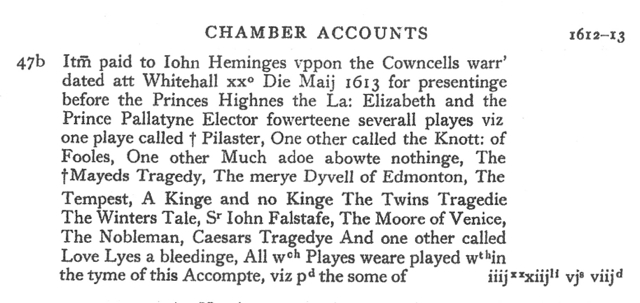Knot of Fools, The
Historical Records
Accounts of the Treasurer of the Chamber
Item 47b (Cook 55-6):
Item paid to Iohn Heminges vppon the Cowncells warrant dated att Whitehall xx0 Die Maij 1613 for presentinge before the Princes Highnes the Lady Elizabeth and the Prince Pallaytne Elector fowerteene severall playes viz one playe called ‡ Pilaster, One other called the Knott: of Fooles, One other Much adoe abowte nothinge, The ‡ Mayeds Tragedy, The merye Dyvell of Edmonton, The Tempest, A Kinge and no Kinge The Twins Tragedie The Winters Tale, Sr Iohn Falstafe, The Moore of Venice, The Nobleman, Caesars Tragedye And one other called Love Lyes a bleedinge, All wch Playes weare played wthin the tyme of this Accompte, viz pd the some of . . . . . . iiijxxxiijli vjs viiijd
Theatrical Provenance
The play was one of 20 performed by the King’s Men at court through the winter holiday season of 1612-13 (the other six plays named are "A Bad Beginning Makes a Good Ending", The Captain, The Alchemist, "Cardenio", "The Hotspurr" (1H4?), and "Benidicte and Betteris" (Much Ado?).
In addition, the Prince’s Men put on the two parts of "The Knaves"; the Children of the Chapel put on The Coxcombe, Cupid’s Revenge, and The Widow’s Tears; Lady Elizabeth’s Men put on Cockle de Moye (The Dutch Courtesan) and "Raymond Duke of Lyons."
The winter of 1612-13 was a bittersweet time for the court. Prince Henry died suddenly of a fever on 6 November 1612, yet the marriage of Princess Elizabeth to the Elector Palatine took place as scheduled on Valentine’s Day, 1613.
Without evidence to the contrary, it is reasonable to assume that "The Knot of Fools" was performed in both of the King's company's London venues, the Globe and Blackfriars.
Probable Genre(s)
Comedy? (Harbage)
Possible Narrative and Dramatic Sources or Analogues
None known.
References to the Play
None known.
Critical Commentary
Knutson, challenging the idea of repertories divided by class taste and basing her argument on titles alone, makes the point that "The Knot of Fools" doesn't sound like a play so sophisticated that its only audience would have been the upscale audiences at Blackfriars (58).
For What It's Worth
Works Cited
Site created and maintained by Roslyn L. Knutson, Professor Emerita, University of Arkansas at Little Rock; updated 30 August 2009.
